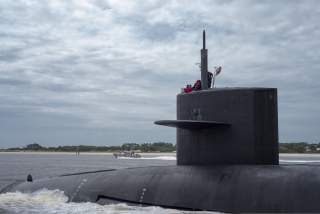U.S. Tests Upgraded Nuclear-Armed, Submarine-Launched Trident II D5 Missiles
The Trident II D5 missile is deployed aboard U.S. Navy Ohio-class submarines and Royal Navy Vanguard-class to deter nuclear aggression.
Nuclear-Armed Trident II D5 missiles rest in 44-foot long missile tubes built into ballistic missile submarines quietly patrolling the undersea domain - to ensure security and peace.
The US Navy is test-firing and upgrading its arsenal of Trident II D5 nuclear-armed submarine launched missiles designed to keep international peace -- by ensuring and undersea-fired second-strike ability in the event of a catastrophic nuclear first strike on the US.
Firing from the Atlantic Ocean off the coast of Florida several months ago, a specially configured non-armed “test” version of the missile was fired from the Navy’s USS Maryland. This was the 161st successful Trident II launch since design completion in 1989.
The missile was converted into a test configuration using a test missile kit produced by Lockheed Martin that contains range safety devices, tracking systems and flight telemetry instrumentation, a Lockheed statement said.
The Trident II D5 missile is deployed aboard U.S. Navy Ohio-class submarines and Royal Navy Vanguard-class to deter nuclear aggression. The three-stage ballistic missile can travel a nominal range of 4,000 nautical miles and carry multiple independently targeted reentry bodies.
The U.S. and UK are collaboratively working on a common missile compartment for their next generation SSBNs, or ballistic missile submarines.
The 130,000-pound Trident II D5 missile can travel 20,000-feet per second, according to Navy figures. The missiles cost $30 million each.
The "Bulletin of the Atomic Scientists" futher describes the weapon -- "The Trident D5s carry three types of warheads: the 100-kiloton W76/Mk-4, the 100-kiloton W76-1/Mk-4A, and the 455-kiloton W88/Mk-5 warhead, the highest-yield ballistic missile warhead in the U.S. arsenal."
Trident II D5 - Nuclear-Armed Missile Upgrade:
The Trident II D5, first fired in the 1990s, is an upgraded version of the 1970s-era Trident I nuclear weapon; the Trident II D5s were initially engineered to serve until 2027, however an ongoing series of upgrades are now working to extend its service life.
The Navy is modernizing its arsenal of Trident II D5 nuclear missiles in order to ensure their service life can extend for 25 more years aboard the Navy’s nuclear ballistic missile submarine fleet, service leaders said.
The 44-foot long submarine-launched missiles have been serving on Ohio-class submarines for 25 years,service leaders explained.
The missiles are also being planned as the baseline weapon for the Ohio Replacement Program ballistic missile submarine, a platform slated to serve well into the 2080s, so the Navy wants to extend the service life of the Trident II D5 missiles to ensure mission success in future decades.
The Navy has been working on technical upgrades to the existing Trident II D 5 in order to prevent obsolescence and ensure the missile system remains viable for the next several decades.
Engineers have modernized the guidance system by replacing two key components due to obsolescence – the inertial measurement unit and the electronics assembly, developers said.
Under the U.S.-Russia New START treaty signed in 2010, roughly 70-percent of the U.S.’ nuclear warheads will be deployed on submarines.
Within the last several years, the Navy has acquired an additional 108 Trident II D 5 missiles in order to strengthen the inventory for testing and further technological development.
As part of the technical improvements to the missile, the Navy is upgrading what’s called the Mk-4 re-entry body, the part of the missile that houses a thermonuclear warhead. The life extension for the Mk-4 re-entry body includes efforts to replace components including the firing circuit, Navy officials explained.
The Navy is also working with the Air Force on refurbishing the Mk-5 re-entry body which will be ready by 2019, senior Navy officials said.
Benedict said the Mk-5 re-entry body has more yield than a Mk-4 re-entry body, adding that more detail on the differences was not publically available.
The missile also has a larger structure called a release assembly which houses and releases the re-entry bodies, Navy officials said. There is an ongoing effort to engineer a new release assembly that will work with either the Mk-4 or Mk-5 re-entry body.
Kris Osborn became the Managing Editor of Scout Warrior in August of 2015. His role with Scout.com includes managing content on the Scout Warrior site and generating independently sourced original material. Scout Warrior is aimed at providing engaging, substantial military-specific content covering a range of key areas such as weapons, emerging or next-generation technologies and issues of relevance to the military. Just prior to coming to Scout Warrior, Osborn served as an Associate Editor at the Military.com. Osborn previously served at the Pentagon as a Highly Qualified Expert with the Office of the Assistant Secretary of the Army - Acquisition, Logistics & Technology. Osborn has also worked as an anchor and on-air military specialist at CNN and CNN Headline News. This story originally appeared in Scout Warrior.

